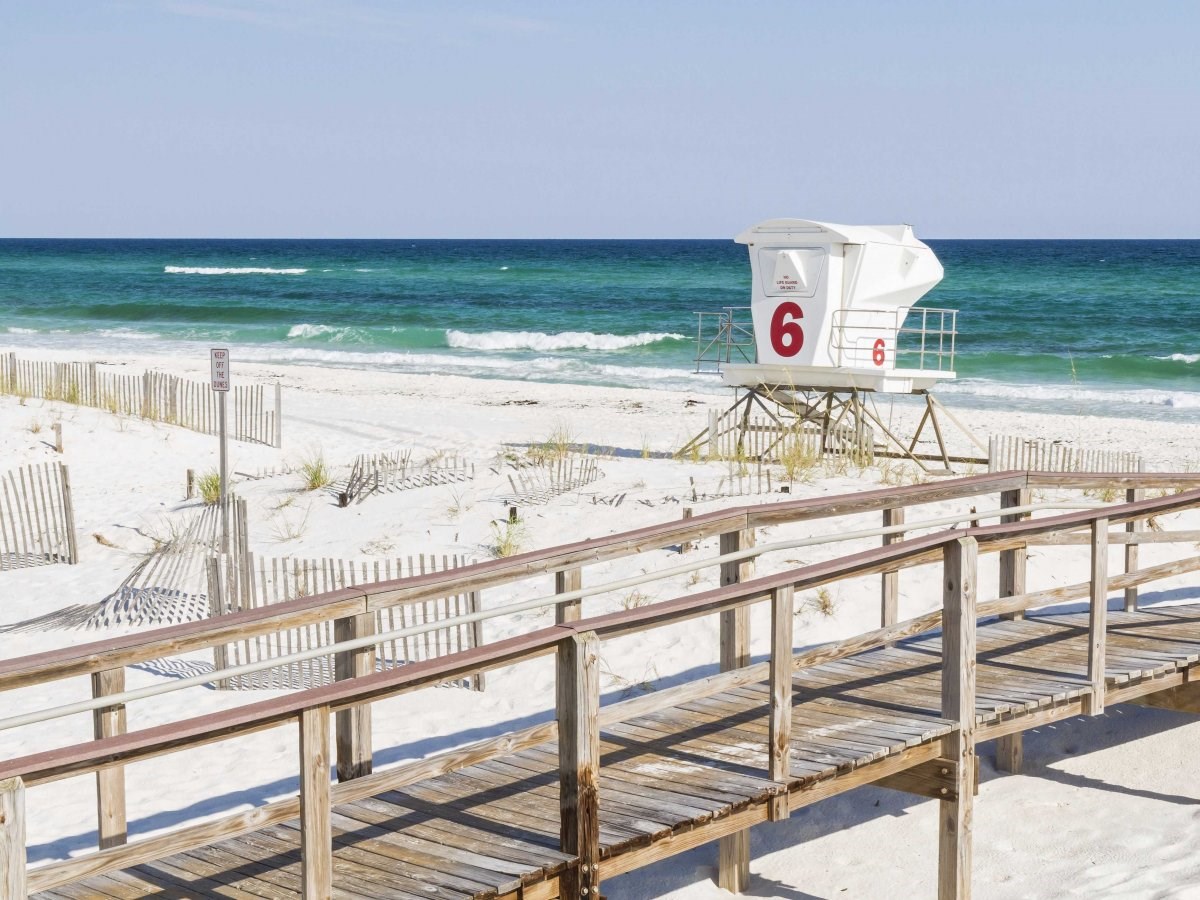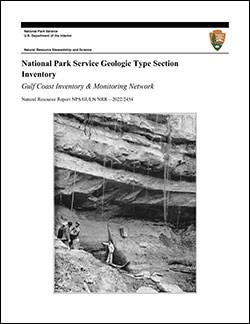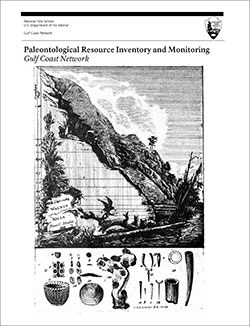
Geology and Stratigraphy of the Gulf Coast I&M Network Parks
The Gulf Coast Inventory and Monitoring Network (GULN) consists of eight national park units in northwestern Alabama, western Florida, Louisiana, Mississippi, western Tennessee, and southeastern Texas. Park units of the Gulf Coast Network include Big Thicket National Preserve, Gulf Islands National Seashore, Jean Lafitte National Historical Park and Preserve, Natchez Trace Parkway, Padre Island National Seashore, Palo Alto Battlefield National Historical Park, San Antonio Missions National Historical Park, and Vicksburg National Military Park. Collectively, the Gulf Coast Network parks occupy more than approximately 184,000 hectares (455,000 acres) and vary in size from 383 hectares (948 acres) in San Antonio Missions to 56,322 hectares (139,175 acres) in Gulf Islands. As the name implies, Gulf Coast Network includes park units of the Gulf Coastal Plain that protect fragile barrier island habitats, internationally recognized biological preserves, Spanish Colonial Era mission complexes, battlefield sites of the U.S.-Mexican War and American Civil War, historic cultural sites of the Mississippi Delta, and the scenic Natchez Trace Parkway.
The Gulf Coast Network parks occupy a great coastal plain bordering the Gulf of America to the north that stretches from the lower Rio Grande valley of Texas east to the Florida Panhandle. The Gulf Coast region of the United States is characterized by a broad, gently dipping sedimentary wedge containing an immense accumulation of hydrocarbon-rich Mesozoic and Cenozoic strata about 15 km (9 mi) thick (Durham and Murray 1967; Buursink et al. 2018; Leathers-Miller 2020; Pitman et al. 2020). The oldest bedrock underlying the park units of Gulf Coast Network are mapped along Natchez Trace Parkway and date to the Paleozoic Era, approximately 485 million years ago. These ancient rocks record the rich geologic evolution of ancestral North America (Laurentia) over hundreds of millions of years and record dynamic plate tectonic processes involving continental-scale collisional events, regional uplifts, folding, faulting, and rifting. Significant geologic events that took place during this time include the formation of the Appalachian–Ouachita mountain belt, rifting of the supercontinent Pangaea, and subsequent erosion and modification by surface processes to form the modern landscape.
The Appalachian Mountains and Ouachita Mountains are the result of several major mountain-building collisional events (orogenies) that include the Taconic, Acadian, Alleghenian, and Ouachita orogenies. The first major orogenic episode, known as the Taconic Orogeny, occurred during the Ordovician Period approximately 470–450 Ma (Mega-annum, million years ago) and involved the accretion of island arc material to the east coast of Laurentia (Gonzalez et al. 2018; Hildebrand and Whalen 2021). During the Devonian Period (410–360 Ma), the Acadian Orogeny resulted in the collision of a large foreign landmass (Avalon terrane) with Laurentia (Gibson et al. 2021). The Alleghenian Orogeny and genetically related Ouachita Orogeny occurred throughout the Pennsylvanian and Permian Periods (325–260 Ma) and involved the collision between Gondwana (a large continent that includes two-thirds of today’s continental area) and Laurentia that culminated with the formation of the supercontinent Pangea (Harry and Londono 2004; Hou at al. 2021; Hillenbrand and Williams 2021).
Following the assembly of Pangea, immense amounts of heat from the mantle accumulated beneath the supercontinent to create regional-scale extensional forces that rifted the supercontinent apart in the Triassic Period (Nance et al. 1988; Harry and Londono 2004). The breakup of Pangea established the modern-day passive margin sequence of North America and opened the Atlantic Ocean and Gulf of America. As the uplifted regions of the Appalachian Mountains and Ouachita Mountains were exposed to erosion, immense amounts of sediment were transported into the coastal and interior lowlands. The detritus shed from these highlands began to accumulate in the Triassic-age rift basins along the Gulf Coast, marking the beginnings of the thick hydrocarbon-rich sedimentary wedge sequence that exists today. The modern landscape of Gulf Coast Network is still largely influenced by fluvial depositional systems (especially the Mississippi River, Rio Grande, and associated tributaries) that continue to transport vast amounts of sediment into the Gulf of America where they are reworked by coastal processes including wind, waves, tides, storms, and sea-level change.
A Brief Geologic History
A few examples of events and Network resources in each geologic time period are highlighted below, from youngest to oldest.
Several formally named Pleistocene sedimentary units of dominantly fluvial-deltaic origin underlie Big Thicket and consist of gravel, sandstone, siltstone, and mudstone of the Willis Formation, Lissie Formation, Beaumont Alloformation, and Deweyville Formation (Chowdhury and Turco 2006; an alloformation is a mappable body of rock that is geographically separated by discontinuity-bounded geologic units of similar lithology). Fluvial deposits of the Beaumont Alloformation also occur in Jean Lafitte, as well as the Avoyelles Alloformation. Calcareous silt, sand, and gravel of the Pleistocene Leona Formation are mapped in San Antonio Missions. Unnamed Pleistocene units include fluvial terrace deposits mapped along Village Creek in Big Thicket and widespread ancestral Mississippi River pre-loess and loess deposits forming the steep river bluffs overlooking the Mississippi River at Vicksburg and along Natchez Trace Parkway from Natchez north to Jackson. Quaternary deposits encompass all stream alluvium and are also associated with abandoned river channels of the ancestral Rio Grande that underlie portions of Palo Alto Battlefield. A diverse variety of Holocene-age surficial deposits occur throughout the park units of the Gulf Coast Network and include barrier island and lagoon geomorphological units (Gulf Islands, Padre Island), fluvial and fluvial-deltaic deposits (Jean Lafitte, Palo Alto Battlefield, San Antonio Missions, Vicksburg), and alluvium (Big Thicket, San Antonio Missions, Vicksburg).
Geology & Soils—Gulf Coast Network Parks
Type Sections—Gulf Coast Network

The geologic history above is excerpted from a report titled, "National Park Service geologic type section inventory: Gulf Coast Inventory & Monitoring Network". Type sections are essential reference locations for the geoscientists who study geologic history and paleontology. A summary of the type sections in each park can be found at the links below.
-
Big Thicket National Preserve, Texas (contains one identified stratotype)
-
Gulf Islands National Seashore, Mississippi and Florida (no designated stratotypes identified)
-
Jean Lafitte National Historical Park and Preserve, Louisiana (no designated stratotypes identified)
-
Natchez Trace Parkway, Mississippi and Tennessee (no designated stratotypes identified)
-
Padre Island National Seashore, Texas (no designated stratotypes identified)
-
Palo Alto Battlefield National Historical Park, Texas (no designated stratotypes identified)
-
San Antonio Missions National Historical Park, Texas (no designated stratotypes identified)
-
Vicksburg National Military Park, Mississippi and Louisiana (contains three identified stratotypes)
The full Network report is available in digital format from:
Please cite this publication as:
- Henderson TC, Santucci VL, Connors T, Tweet JS. 2022. National Park Service geologic type section inventory: Gulf Coast Inventory & Monitoring Network. Natural Resource Report. NPS/GULN/NRR—2022/2454. National Park Service. Fort Collins, Colorado.
NPS Stratotype Inventory
Fossil Resources—Gulf Coast Network

Between 2002 and 2011, network-based paleontological resource inventories were completed for all the 32 I&M networks, and six of the earliest were completely updated between 2012 and 2016. The report linked below summarizes the paleontological resources of all park units in the Gulf Coast Inventory & Monitoring Network (GULN). The report provides geologic background and paleontological resource data for each park to support management operations, planning, and science-based decision making as required by NPS management policies and the Paleontological Resources Preservation Act (2009).
The full report is available in digital format from
Please cite this publication as:
-
Kenworthy, J. P., V. L. Santucci, and C. C. Visaggi. 2007. Paleontological Resource Inventory and Monitoring, Gulf Coast Network. National Park Service TIC# D-750. 103 pages.
Geodiversity Atlas pages—by Inventory & Monitoring Network
Arctic Network Index
Central Alaska Network Index
Chihuahuan Desert Network Index
Cumberland Piedmont Network Index
Eastern Rivers and Mountains Network Index
Great Lakes Network Index
Greater Yellowstone Network Index
Gulf Coast Network Index
Heartland Network Index
Klamath Network Index
Mediterranean Coast Network Index
Mid-Atlantic Network Index
Mojave Desert Network Index
National Capital Network Index
North Coast and Cascades Network Index
Northeast Coastal and Barrier Network Index
Northeast Temperate Network Index
Northern Colorado Plateau Network Index
Northern Great Plains Network Index
Pacific Islands Network Index
Rocky Mountain Network Index
San Francisco Bay Area Network Index
Sierra Nevada Network Index
Sonoran Desert Network Index
South Florida/Caribbean Network Index
Southeast Alaska Network Index
Southeast Coast Network Index
Southern Colorado Plateau Network Index
Southern Plains Network Index
Southwest Alaska Network Index
Upper Columbia Basin Network Index
Geodiversity Atlas pages—by State, U.S. Commonwealth, and Territories
Alabama | Alaska | Arizona | Arkansas | California | Colorado | Connecticut | District of Columbia | Delaware | Florida | Georgia | Hawaii | Idaho | Illinois | Indiana | Iowa | Kansas | Kentucky | Louisiana | Maine | Maryland | Massachusetts | Michigan | Minnesota | Mississippi | Missouri | Montana | Nebraska | Nevada | New Hampshire | New Jersey | New Mexico | New York | North Carolina | North Dakota | Ohio | Oklahoma | Oregon | Pennsylvania | Rhode Island | South Carolina | South Dakota | Tennessee | Texas | Utah | Vermont | Virginia | Washington | West Virginia | Wisconsin | Wyoming
U.S. Commonwealth and Territories
Region 2: South Atlantic-Gulf (Includes Puerto Rico and the U.S. Virgin Islands)
Region 3: Great Lakes
Region 4: Mississippi Basin
Region 5: Missouri Basin
Region 6: Arkansas-Rio Grande-Texas-Gulf
Region 7: Upper Colorado Basin
Region 8: Lower Colorado Basin
Region 9: Columbia-Pacific Northwest
Region 10: California-Great Basin
Region 11: Alaska
Region 12: Pacific Islands (American Samoa, Hawaii. Guam, Commonwealth of the Northern Mariana Islands)
Last updated: February 27, 2025
